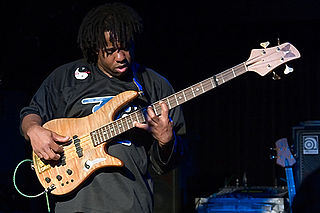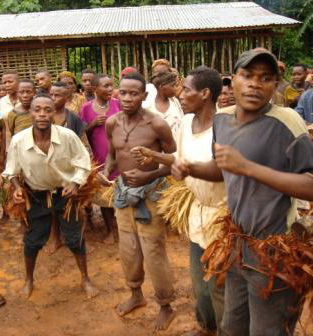Related Research Articles

A percussion instrument is a musical instrument that is sounded by being struck or scraped by a beater including attached or enclosed beaters or rattles struck, scraped or rubbed by hand or struck against another similar instrument. Excluding zoomusicological instruments and the human voice, the percussion family is believed to include the oldest musical instruments. In spite of being a very common term to designate instruments, and to relate them to their players, the percussionists, percussion is not a systematic classificatory category of instruments, as described by the scientific field of organology. It is shown below that percussion instruments may belong to the organological classes of idiophone, membranophone, aerophone and chordophone.

A jazz band is a musical ensemble that plays jazz music. Jazz bands vary in the quantity of its members and the style of jazz that they play but it is common to find a jazz band made up of a rhythm section and a horn section.

Gamelan is the traditional ensemble music of the Javanese, Sundanese, and Balinese peoples of Indonesia, made up predominantly of percussive instruments. The most common instruments used are metallophones and a set of hand-drums called kendang, which keep the beat. The kemanak, a banana-shaped idiophone, and the gangsa, another metallophone, are also commonly used gamelan instruments on Bali. Other notable instruments include xylophones, bamboo flutes, a bowed string instrument called a rebab, and a zither-like instrument called a siter, used in Javanese gamelan. Additionally, vocalists may be featured, being referred to as sindhen for females or gerong for males.
Given the vastness of the African continent, its music is diverse, with regions and nations having many distinct musical traditions. African music includes the genres amapiano, jùjú, fuji, afrobeat, highlife, Congolese rumba, soukous, ndombolo, makossa, kizomba,Taarab and others. African music also uses a large variety of instruments from all across the continent. The music and dance of the African diaspora, formed to varying degrees on African musical traditions, include American music like Dixieland jazz, blues, jazz, and many Caribbean genres, such as calypso and soca. Latin American music genres such as cumbia, salsa music, son cubano, rumba, conga, bomba, samba and zouk were founded on the music of enslaved Africans, and have in turn influenced African popular music.

Bassline is the term used in many styles of music, such as blues, jazz, funk, dub and electronic, traditional, and classical music, for the low-pitched instrumental part or line played by a rhythm section instrument such as the electric bass, double bass, cello, tuba or keyboard.

Indigenous music of North America, which includes American Indian music or Native American music, is the music that is used, created or performed by Indigenous peoples of North America, including Native Americans in the United States and Aboriginal peoples in Canada, Indigenous peoples of Mexico, and other North American countries—especially traditional tribal music, such as Pueblo music and Inuit music. In addition to the traditional music of the Native American groups, there now exist pan-Indianism and intertribal genres as well as distinct Native American subgenres of popular music including: rock, blues, hip hop, classical, film music, and reggae, as well as unique popular styles like chicken scratch and New Mexico music.
Traditional Inuit music, the music of the Inuit, Yupik, and Iñupiat, has been based on drums used in dance music as far back as can be known, and a vocal style called katajjaq has become of interest in Canada and abroad.

Pygmy music refers to the sub-Saharan African music traditions of the Central African foragers, predominantly in the Congo, the Central African Republic and Cameroon.

A rhythm section is a group of musicians within a music ensemble or band that provides the underlying rhythm, harmony and pulse of the accompaniment, providing a rhythmic and harmonic reference and "beat" for the rest of the band. The rhythm section is often contrasted with the roles of other musicians in the band, such as the lead guitarist or lead vocals whose primary job is to carry the melody.

The Baka people, known in the Congo as Bayaka, are an ethnic group inhabiting the southeastern rain forests of Cameroon, northern Republic of the Congo, northern Gabon, and southwestern Central African Republic. They are sometimes called a subgroup of the Twa, but the two peoples are not closely related. Likewise, the name "Baka" is sometimes mistakenly applied to other peoples of the area who, like the Baka and Twa, have been historically called pygmies, a term that is now considered derogatory.

The music of West Africa has a significant history, and its varied sounds reflect the wide range of influences from the area's regions and historical periods.
Xhosa music has long been a major part of the music of South Africa, especially in the field of jazz. Since olden times, singing has been a tradition and part of culture among the Xhosas.
Baka Beyond is a world music group formed in 1992 with members from a wide variety of backgrounds and cultures, fusing Celtic and other western music styles with traditional Baka music from Cameroon.

In many parts of sub-Saharan Africa, the use of music is not limited to entertainment: it serves a purpose to the local community and helps in the conduct of daily routines. Traditional African music supplies appropriate music and dance for work and for religious ceremonies of birth, naming, rites of passage, marriage and funerals. The beats and sounds of the drum are used in communication as well as in cultural expression.
The music of the ancient Mayan courts is described throughout native and Spanish 16th-century texts and is depicted in the art of the Classic Period. The Maya played instruments such as trumpets, flutes, whistles, and drums, and used music to accompany funerals, celebrations, and other rituals. Although no written music has survived, archaeologists have excavated musical instruments and painted and carved depictions of the ancient Maya that show how music was a complex element of societal and religious structure. Most of the music itself disappeared after the dissolution of the Maya courts following the Spanish Conquest. Some Mayan music has prevailed, however, and has been fused with Spanish influences.

Jazz improvisation is the spontaneous invention of melodic solo lines or accompaniment parts in a performance of jazz music. It is one of the defining elements of jazz. Improvisation is composing on the spot, when a singer or instrumentalist invents melodies and lines over a chord progression played by rhythm section instruments and accompanied by drums. Although blues, rock, and other genres use improvisation, it is done over relatively simple chord progressions which often remain in one key.

Jazz drumming is the art of playing percussion in jazz styles ranging from 1910s-style Dixieland jazz to 1970s-era jazz fusion and 1980s-era Latin jazz. The techniques and instrumentation of this type of performance have evolved over several periods, influenced by jazz at large and the individual drummers within it. Stylistically, this aspect of performance was shaped by its starting place, New Orleans, as well as numerous other regions of the world, including other parts of the United States, the Caribbean, and Africa.

This is a glossary of jazz and popular music terms that are likely to be encountered in printed popular music songbooks, fake books and vocal scores, big band scores, jazz, and rock concert reviews, and album liner notes. This glossary includes terms for musical instruments, playing or singing techniques, amplifiers, effects units, sound reinforcement equipment, and recording gear and techniques which are widely used in jazz and popular music. Most of the terms are in English, but in some cases, terms from other languages are encountered.
'Kwakwaka'wakw music is a sacred and ancient art of the Kwakwaka'wakw peoples that has been practiced for thousands of years. The Kwakwaka'wakw are a collective of twenty-five nations of the Wakashan language family who altogether form part of a larger identity comprising the Indigenous Peoples of the Pacific Northwest Coast, located in what is known today as British Columbia, Canada.
Bigwala is a genre of ceremonial music and dance of the Busoga Kingdom in Uganda centered around gourd trumpets.
References
- ↑ "Music". George Mason University. 2009-10-07. Retrieved 2009-10-26.
- 1 2 3 Campagnoli, Mauro (2008-10-08). "Baka Pygmies - About this site and Copyright notice". Archived from the original on 23 November 2009. Retrieved 2009-10-26.
- 1 2 Titon, Jeff (2009). Worlds of Music: An Introduction to the Music of the World's Peoples. Canada: Clark Baxter.
- ↑ Kisliuk, Michelle (1998). Seize The Dance! aAka Musical Life and the Ethnography of Performance. New York, Oxford: Oxford University Press.